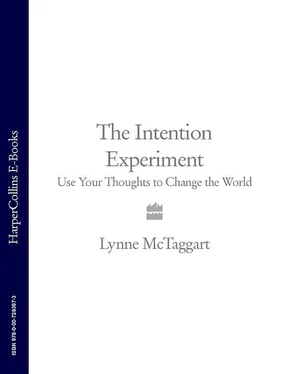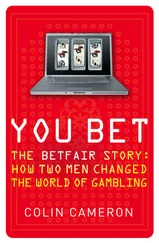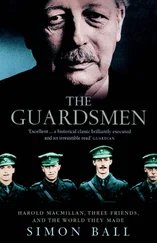At that point in my journey, I ran out of pavement. All that stretched before me, as far as I could tell, was uninhabited open terrain.
Then one evening, my husband Bryan, a natural entrepreneur in most situations, put forward what seemed to be a preposterous suggestion: ‘Why don’t you do some group experiments yourself?’
I am not a physicist. I am not any kind of scientist. The last experiment I had conducted had been in a 10th grade science lab.
What I did have, though, was a resource available to few scientists: a potentially huge experimental body. Group intention experiments are extraordinarily difficult to perform in an ordinary laboratory. A researcher would need to recruit thousands of participants. How would he find them? Where would he put them? How would he get them all to think the same thing at the same time?
A book’s readers offer an ideal self-selected group of likeminded souls who might be willing to participate in testing out an idea. Indeed, I already had my own large population of regular readers with whom I communicated through e-news and my other spin-off activities from The Field .
I first broached the idea of carrying out my own experiment with dean emeritus of the Princeton University School of Engineering Robert Jahn and his colleague, psychologist Brenda Dunne, who run the Princeton Engineering Anomalous Research (PEAR) laboratory, both of whom I had got to know through my research for The Field . Jahn and Dunne have spent some 30 years painstakingly amassing some of the most convincing evidence about the power of directed intention to affect machinery. They are absolute sticklers for scientific method, no-nonsense and to the point. Robert Jahn is one of the few people I have ever met who speaks in perfect, complete sentences. Brenda Dunne is equally perfectionist about detail in both experiment and language. I would be assured of no sloppy protocol in my experiments if Jahn and Dunne agreed to be involved.
The two of them also have a vast array of scientists at their disposal. They head the International Consciousness Research Laboratory, many of whose members are among the most prestigious scientists performing consciousness research in the world. Dunne also runs PEARTree, a group of young scientists interested in consciousness research.
Jahn and Dunne immediately warmed to the idea. We met on numerous occasions and kicked around some possibilities. Eventually, they put forward Fritz-Albert Popp, assistant director of the International Institute of Biophysics (IIB) in Neuss, Germany, to conduct the first intention experiments. I knew Fritz Popp through my research for The Field . He was the first to discover that all living things emit a tiny current of light. As a noted German physicist recognized internationally for his discoveries, Popp would also be a stickler for pristine scientific method.
Other scientists, such as psychologist Gary Schwartz of the Biofield Center at the University of Arizona, Marilyn Schlitz, vice president for research and education at the Institute of Noetic Sciences, Dean Radin, IONS’ senior scientist, and psychologist Roger Nelson of the Global Consciousness Project, have also offered to participate.
I do not have any hidden sponsors of this project. The website and all our experiments will be funded by the proceeds of this book or grants, now and in the future.
Scientists involved in experimental research often cannot venture beyond their findings to consider the implications of what they have uncovered. Consequently, when assembling the evidence that already exists about intention, I have tried to consider the larger implications of this work and to synthesize these individual discoveries into a coherent theory. In order to describe in words concepts that are generally depicted through mathematical equations, I have had to reach for metaphoric approximations of the truth. At times, with the help of many of the scientists involved, I have also had to engage in speculation. It is important to recognize that the conclusions arrived at in this book represent the fruits of frontier science. These ideas are a work in progress. Undoubtedly new evidence will emerge to amplify and refine these initial conclusions.
Researching the work of people at the very forefront of scientific discovery again has been a humbling experience for me. Within the unremarkable confines of a laboratory, these largely unsung men and women engage in activities that are nothing short of heroic. They risk losing grants, academic posts and, indeed, entire careers groping alone in the dark. Most scratch around for grant money to enable them to carry on.
All advancements in science are somewhat heretical, each important new discovery partly, if not completely, negating the prevailing views of the day. To be a true explorer in science – to follow the unprejudiced lead of pure scientific inquiry – is to be unafraid to propose the unthinkable, and to prove friends, colleagues and scientific paradigms wrong. Hidden within the cautious, neutral language of experimental data and mathematical equation is nothing less than the makings of a new world, which slowly takes shape for all the rest of us, one painstaking experiment at a time.
Lynne McTaggart, June 2006
1. N. Hill, Think and Grow Rich: The Andrew Carnegie Formula for Money Making , New York: Ballantine Books (reissue edn), 1987.
2. J. Fonda, My Life So Far , London: Ebury Press, 2005: 571.
THE INTENTION EXPERIMENT is no ordinary book, and you are no ordinary reader. This is a book without an ending, for I intend for you to help me finish it. You are not only the audience of this book, but also one of its protagonists – the primary participants in cutting-edge scientific research. You, quite simply, are about to embark on the largest mind-over-matter experiment in history.
The Intention Experiment is the first ‘living’ book in three-dimensions. The book, in a sense, is a prelude, and the ‘contents’ carry on well beyond the time you finish the final page. In the book itself, you will discover scientific evidence about the power of your own thoughts, and you will then be able to extend beyond this information and test further possibilities through a massive, ongoing international group experiment, under the direction of some of the most well-respected international scientists in consciousness research. Through The Intention Experiment’s website (www.theintention experiment.com), you and the rest of the readers of this book will be able to participate in remote experiments, the results of which will be posted on the site. Each of you will become a scientist at the hub of some of the most daring consciousness experiments ever conducted.
The Intention Experiment rests on an outlandish premise: thought affects physical reality. A sizeable body of research exploring the nature of consciousness, carried on for more than 30 years in prestigious scientific institutions around the world, shows that thoughts are capable of affecting everything from the simplest machines to the most complex living beings. 1This evidence suggests that human thoughts and intentions are an actual physical ‘something’ with the astonishing power to change our world. Every thought we have is a tangible energy with the power to transform. A thought is not only a thing; a thought is a thing that influences other things.
This central idea, that consciousness affects matter, lies at the very heart of an irreconcilable difference between the world view offered by classical physics – the science of the big, visible world – and that of quantum physics – the science of the world’s most diminutive components. That difference concerns the very nature of matter and the ways it can be influenced to change.
Читать дальше











